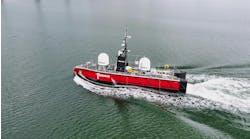First FPSO in GoM inevitable
The first FPSO in the Gulf of Mexico is now a foregone conclusion with Bergesen’s announcement that it has awarded Sembawang Shipyard, a wholly-owned subsidiary of SembCorp Marine, an S$88 million contract to convert the Ultra Large Crude Carrier,BW Enterprise into an FPSO. The floating production facility will be installed on the Pemex-operated Ku-Maloob-Zaap field in Mexico’s Bay of Campeche, located 105 km northwest of Ciudad del Carmen.
Bergesen Worldwide Offshore, a unit of the Bergesen Worldwide Group, will own and operate the FPSOBerge Carmen under a 15-year term agreement with Pemex.
Sembawang’s contracted workscope includes conversion of the 360,000 dwt tanker into an FPSO capable of handling 600,000 b/d inclusive of 200,000 b/d processing capacity with gas export capability. The shipyard will carry out detailed engineering, procurement of bulk materials, vessel repair and conversion, installation of topsides modules and the internal turret as well as precommissioning work. The vessel’s accommodation module will also be upgraded and refurbished to house up to 110 people.
Sembawang Shipyard is converting the ULCC BW Enterprise into an FPSO for Bergesen Worldwide Offshore for operations in the GoM.
The vessel is scheduled to be delivered to Bergesen in 4Q 2006, followed by installation and first production by April 2007. The FPSO will serve as a production hub and export terminal in the area.
In other Bergesen-FPSO related news, the company says it has acquired the 142,000-dwt FPSOWhakaaropai from Shell Todd Oil Services Ltd. The 1976-built Suezmax-sized vessel is currently operating on the Maui B oil field offshore New Zealand. Due to the field’s rapid depletion, the FPSO will be decommissioned and transferred to its new owners in 1Q 2006. The vessel will be jointly owned by Arne Blystad with a 50% working interest.
The FPSO is equipped with an external turret, storage capacity for 1 MMbbl, oil production for 31,000 b/d, water processing for 14,000 b/d, and gas facilities for throughput of 27 MMcf/d.
Bergesen says the FPSO’s technical features allow for feasible development of small, marginal fields.
Cal Dive enhances deepwater asset portfolio
Cal Dive has announced that it will add a deepwater pipelay vessel to its construction fleet and intends to add a drilling package to its semisubmersibleQ4000.
The company says it plans to convert a four-year old vessel, originally built for the cable lay market, into a deepwater pipelay asset. The 485-ft vessel,Caesar, comes equipped with a DP2 system and will be fitted with a conventional S-lay pipelay package and new crane.
The company expects the vessel to be ready for service at the end of 1Q 2007.
Cal Dive also announced that it plans to enhance the capabilities of itsQ4000through installation of a drilling system. The $30 million upgrade program includes the addition of a modular-based drilling system, which is based on hybrid slimbore technology. According to Cal Dive, this will enable optimal exploration and appraisal of deepwater reservoirs, while equipping theQ4000with capacity to complete wells in up to 6,000 ft of water.
PGS Production secures tanker; targets international market
Norway-based PGS Production, a wholly owned subsidiary of Petroleum Geo-Services ASA, says it has secured a tanker for conversion into an FPSO.
PGS has entered into an agreement with Norway-based Knutsen OAS Shipping for purchase
of the M/TRita Knutsen for $35 million. The 124,472-dwt double-hulled vessel was built by Daewoo Shipyard in Korea in 1986.
PGS has acquired the M/T Rita Knutsen from Knutsen OAS Shipping for potential conversion into an FPSO.
The company says the vessel is a candidate for several upcoming projects, however conversion of the ship will not be started until a firm operating contract for the ship is secured in the market.
In other floating production news, Expro International Group Plc secured contracts worth over $50 million for supply of an Early Production System (EPS) and an Extended Well Testing (EWT) facility.
The company was awarded a contact by Chevron Nigeria Ltd. to supply a barge mounted EPS capable of producing 50,000 b/d and processing of 100,000 b/d of water injection. The barge is schedule to start operations on-site in 1Q 2006 under a firm two-year commitment.
Expro was also awarded a contact by Shell Brazil Ltd. to supply an EWT for its drilling program in the Santos Basin offshore Brazil. The 10,000 b/d facility is scheduled to be mobilized in 2Q 2006.
Rig reactivations
Transocean says a reactivation program is underway on its semisubmersibleTransocean Winneragainst a three-year commitment with Hydro on the Norwegian Continental Shelf. The rig is expected to begin operations on the contract by October 2006.
According to Transocean, the 1,500-ft rated semi has been idle in Norway since August 2002. Following this reactivation, the drilling contractor’s idle floater capacity is reduced to three semisubmersibles and one drillship.
Diamond Offshore has also initiated reactivation of a cold-stacked semisubmersible rig. The contractor says a major upgrade of the Victory-class semisubmersibleGarden Banks, renamedOcean Monarch, is underway. The rig, which will be upgraded to operate in water depths up to 10,000 ft in a moored configuration, is expected to be ready for service in 4Q 2008.
Diamond says theMonarch is currently cold-stacked in the GoM and is schedule to mobilize to Keppel FELS’ shipyard in Singapore in mid-2006 for the upgrade work.
In other rig construction news, PPL Shipyard has secured a contract with Aban Singapore Pte Ltd. for construction of a Baker Marine Pacific Class 375 Deep Drilling Offshore jackup worth $175 million. Construction of the jackup is scheduled to start in 1Q 2006 with delivery expected in mid-2008.
The rig will be fitted with a package for drilling of high pressure and high temperature wells at 30,000 ft, in up to 375 ft of water.•





